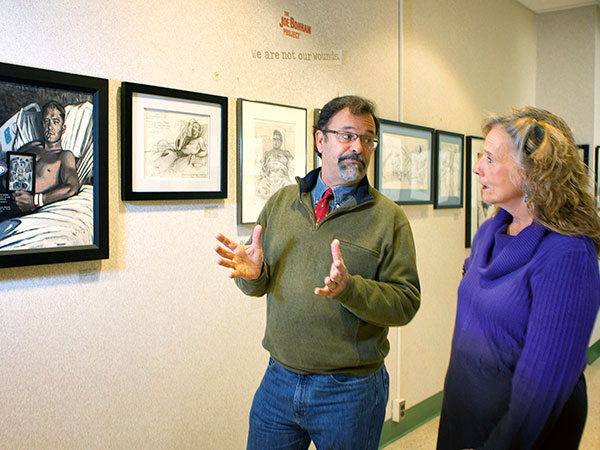Philadelphia Inquirer, Friday, November 1, 2013, Front Page:
Drexel University's Joe Bonham project highlights human cost of war
Drexel University opens The Joe Bonham Project, a collection of 40 drawings and paintings of severely wounded veterans of the Iraq and Afghan wars, as part of a new class on images of war and how people absorb and make sense of those pictures and videos. Here, Mike Fay, the former Marine who created the project, talks about the work with Karen Curry, who is teaching the class on war images at Drexel. ( Ed Hille / Staff Photographer)
People need to look past the men's missing limbs, Marine Corps artist Michael Fay said, to see the resilience in their faces. Even if those faces are scarred and misshapen.
One portrait shows Sgt. David Adams, a young Marine from Wisconsin, using his remaining arm to hold an X-ray of his broken back. Cpl. Zachary Stinson has lost both legs. The face of Lance Cpl. Kyle Carpenter, who was wounded by a hand grenade, looks like cracked porcelain.
Those and dozens more paintings and sketches make up the Joe Bonham Project, created by Fay and showing at Drexel University as part of a new course on how war is portrayed in the media. Many of the recovering Iraq and Afghanistan veterans were drawn in stateside hospitals within weeks of being shot or blown up.
"We're saying, 'Here they are. They're still in the fight,' " Fay said. "They're in a whole different place that people need to know about and hear about."
Bonham, fighting on the front in World War I, miraculously survives being blown up by an artillery shell. Waking in a hospital, he slowly realizes he has lost his arms, legs, eyes, ears, and mouth. He cannot speak, hear, or see.
Using his head to tap out Morse code, Bonham tells the hospital officials he wants to be placed in a glass box and sent on tour to show people the true cost of war. The generals refuse, knowing it would be difficult to recruit young men if Bonham were seen.
"Basically, what we're doing, we're bringing Joe Bonham back out," Fay said.
Unlike Trumbo's pointedly antiwar book, Fay says this project is apolitical, aiming to honor the men who fought for their country and support them as they heal. And to show people - if they want to truly see - the reality of war.
"We don't want to face the actual aftermath and results of war," said Karen Curry, who teaches the Drexel course Imaging War. "It's messy. It's forever. It's something that people have averted their eyes from."
Curry teaches in Drexel's Westphal College of Media Arts and Design, where she directs the Kal and Lucille Rudman Institute for Entertainment Industry Studies. Her course centers on guest speakers, and though 30 students enrolled, attendance at events has averaged 70.
War images always have been recorded and interpreted, from prehistoric cave paintings to Civil War daguerreotypes and movies like Full Metal Jacket. Today, after initial nonstop reporting, news coverage of Iraq and Afghanistan has receded.
Part of the reason is time. The war in Iraq lasted eight years; the war in Afghanistan is still going on after 12. The front line is far away, and the war is fought by volunteers - no draft threatens to sweep sons into danger.
Further explanation lies in the diminished financial status of many news organizations. Struggling newspapers and television stations can't afford to send correspondents for the duration, as was routine in World War II and the Vietnam War.
"There isn't very much coverage at all," said Curry, 64, a former London bureau chief for NBC News. "It's kind of almost an invisible war."
But in a free society, it's crucial for people to know what's occurring in their name - and potentially to their families - through the decisions of the people they elect, she said. That's why her class is studying the Joe Bonham Project.
"I remember landing on my stomach right after the explosion," a soldier says in text that accompanies the exhibit. "Concerned, I started looking around to see who stepped on it, but then the pain kicked in - and I realized it was me."
Fay, 60, served in the Marine Corps as a mortarman from 1975 to 1978, reenlisted from 1983 to 1993, and from 2000 to 2010 was a Corps artist in uniform, serving multiple tours in Afghanistan and Iraq.
In early 2011, he and a group of American, Canadian, and Australian artists, including the celebrated illustrator Victor Juhasz, began drawing members of what they called a new generation of wounded vets.
"You see a lot of direct gazes," Fay said. "These guys are looking right at you."
None of the soldiers want sympathy, he said. They all want their stories faithfully depicted - and heard by the world outside the hospital and the military. All volunteered to be drawn, to show, as the project subtitle states, "We are not our wounds."
"We want to get these faces, get these stories, into the culture," Fay said. "These guys have given their blood and treasure. We hope it's not forgotten."
jgammage@phillynews.com
Read more at http://www.philly.com/philly/education/20131101_Drexel_project_highlights_human_cost_of_war.html#01K8t5AtyRBoHwVh.99


No comments:
Post a Comment